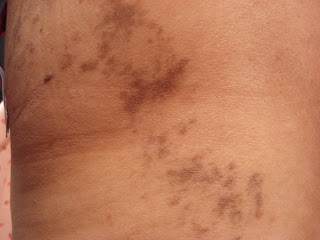This 21 year-old college student presented with a 5 week
history of an evolving lesion on the right leg.
She is in good health and takes no medications by mouth. The lesion started with pruritus and pain and
a solitary evolving bulla on her right leg.
She had walked through a wooded area the night before this developed. It
has evolved into a dry eschar. She has a
history of a DVT on her right leg 2 years ago after tonsillectomy, bed rest and
a long plane trip while on oral contraceptives.
To date, she has been treated with mupirocin ointment and a topical
corticosteroid.
O/E: When seen there was a solitary 2 cm eschar on her right
leg. No erythema, no purulence.
Photos:
 |
| September 8, 2019 a.m. |
 |
| September 8, 2019 p.m. |
 |
| September 9, 2019 |
 |
| September 28, 2019 |
 |
| October 9, 2019 |
 |
| October 16, 2019 (Date of visit) |
Labs: Pending
Diagnosis: Eschar.
Etiologic considerations:
Envenomation – Brown Recluse Spider Bite
Echthyma gangrenosum
Pyoderma gangrenosum (Antiphospholipid syndrome)
Pyoderma gangrenosum (Antiphospholipid syndrome)
A lesion such as this in a young healthy immunocompetent woman
suggests an antecedent insult such as a brown recluse spider bite, but we have
no history to confirm that. She is being
worked up for underlying disorders that might predispose to echthyma. However the antecedent DVT makes one consider an underlying problem such as the antiphospholipid syndrome.
Questions:
1. What diagnoses do
you entertain?
2. At this time, what
therapies do you recommend?
About Hydrocolloid Dressings.
1. Background.
2. Another useful resource on hydrogels.
3. Video Demonstration.
About Hydrocolloid Dressings.
1. Background.
2. Another useful resource on hydrogels.
3. Video Demonstration.
Reference:
The rash that leads to eschar formation. Dunn C, Rosen T.
Clin Dermatol. 2019 Mar - Apr;37(2):99-108. Author
information
Abstract: When
confronted with an existent or evolving eschar, the history is often the most
important factor used to put the lesion into proper context. Determining
whether the patient has a past medical history of significance, such as renal
failure or diabetes mellitus, exposure to dead or live wildlife, or underwent a
recent surgical procedure, can help differentiate between many etiologies of
eschars. Similarly, the patient's overall clinical condition and the presence
or absence of fever can allow infectious processes to be differentiated from
other causes. This contribution is intended to help dermatologists identify and
manage these various dermatologic conditions, as well as provide an algorithm
that can be utilized when approaching a patient presenting with an eschar. Full Text.






























